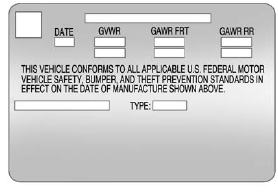Certification Label

Label Example
A vehicle-specific Certification label is attached to either the driver door edge or the lower center pillar on the driver side of the vehicle. The label tells the gross weight capacity of the vehicle, called the Gross Vehicle Weight Rating (GVWR).
The GVWR includes the weight of the vehicle, all occupants, fuel, and cargo. Never exceed the GVWR for the vehicle, or the Gross Axle Weight Rating (GAWR) for either the front or rear axle.
If the vehicle is carrying a heavy load, it should be spread out.
See “Steps for Determining Correct Load Limit” earlier in this section.
WARNING!
Do not load the vehicle any
heavier than the Gross
Vehicle Weight Rating
(GVWR), or either the
maximum front or rear Gross
Axle Weight Rating (GAWR).
This can cause systems to
break and change the way the
vehicle handles. This could
cause loss of control and a
crash. Overloading can also
shorten the life of the vehicle.
WARNING!
Things inside the vehicle can
strike and injure people in a
sudden stop or turn, or in
a crash.
- Put things in the cargo
area of the vehicle. In the
cargo area, put them as
far forward as possible.
Try to spread the weight
evenly.
- Never stack heavier
things, like suitcases,
inside the vehicle so that
some of them are above
the tops of the seats.
- Do not leave an
unsecured child restraint
in the vehicle.
- Secure loose items in the
vehicle.
- Do not leave a seat folded
down unless needed.
See also:
Liftgate
WARNING
Exhaust gases can enter the vehicle if it is driven with the liftgate or trunk/hatch
open, or with any objects that pass through the seal between the body and the trunk/hatch
or lift ...
Feature Settings Menu Items
The following are customization features that allow you to program settings to
the vehicle:
DISPLAY IN ENGLISH
This feature will only display if a language other than English has been set.
This ...
Rear Vision Camera (RVC)
If available, the RVC displays a view of the area behind the vehicle when
the vehicle is shifted into R (Reverse). The display will appear on either the
inside rearview mirror or navigation screen, ...






